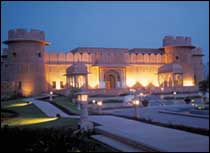


 Is RAJVILAS a five-star hotel, resort or spa? It is neither. And it is all. BEHRAM CONTRACTOR discovers it is a magical region in Rajasthan - an oasis of elegance and luxury.
Is RAJVILAS a five-star hotel, resort or spa? It is neither. And it is all. BEHRAM CONTRACTOR discovers it is a magical region in Rajasthan - an oasis of elegance and luxury. |
|
At the exit to the Jaipur air terminal, three men stood in pink Rajasthani turbans, holding Rajvilas boards in their hands. We checked our name, signaled to the man; he took the luggage from our hand, led us to the car park and a Sierra, put us in, put our luggage in, got in the driver's seat, unsealed two wet and cologned towels from a plastic bag, handed them to us, took out two glasses, also hygienically sealed, and mineral water, passed them on, then, just when we had concluded he did not speak, he did. "What music would you like to hear, Western or Indian classical?" Neither, we told him.
"Would you like to make a telephone call?" he inquired, pointing a mobile towards us. We could not think of anybody to call.
"My name is Allahbax, it is 20 kms. to the hotel and it will take 40 minutes," he said, and plunged into a traffic of camel-carts, auto-rickshaws, and Jaipurians riding to office on the tops of buses. But the land quickly changed to a dry, bleak, landscape with craggy hills, scraped clean, as if with a razor. And it is in this area that P. R. S. Biki Oberoi, vice-chairman and MD of the Oberoi chain, built his Rajvilas, like Kublai Khan building his pleasure dome in Xanadu. I am no Coleridge, but I will try and do justice to the place.
From the outside, it is like a castle, broad and flat, with long marble steps climbing up to it, past fountains and running waters and little cisterns packed with fresh rose petals. In the morning sun, the castle walls had an oleander pink glow about them, which is the signature colour of Jaipur City. A man and a woman, dressed in Tarun Tahiliani uniforms, came out of the monumental brass-clad doors to welcome us. The entire staff is dressed by Tahiliani, the women in Rajasthani skirts, an overblouse, an odhni and heavy jodas, the men in yellow turbans, pink kurtas and trousers. I like the way Tahiliani dresses his models, not hotel staff. Inside, it was like a Rajasthani museum or Rana Pratap Singh's palace. Mughal style frescoes, paintings with dyes made from semi-precious stones decorating the cusped arches, crystal chandeliers dating back to the Raj, a library bar paneled in Burmese teak, a dining room with the sunlight streaming in, appropriately named Surya Mahal, and immediately adjoining it an open air dining area, lit by masals, and with live performers entertaining the diners as they go through their polenta crusted panseared yellowing tuna with fennel infused tamarind chutney.
|

Home Page
About the mag
Subscribe
Advertise
Contact Us